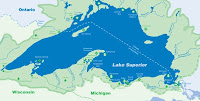 |
| Lake Superior |
Lake Superior receives no rivers of importance, although hundreds of small rivers pour themselves into it, the largest being the St. Louis and the Nipigon. Its aggregate drainage area is 80,400 sq.m. Near Dog Lake (318 miles east of Port Arthur) a short portage connects streams flowing to Lake Superior with others flowing north to Hudson Bay. The Sault Ste. Marie Canal (¾ m., opened 1895) gives continuous navigation from the head of Lake Superior to the sea, 2384 miles.
The bold northern coast is fringed with rocky islands, some rising from deep water to 1300 ft. above the lake. The largest island is Isle Royale, which is 44 mi. long. The southern shore is generally lower and more sandy, with occasional ridges of limestone. Keweenaw Point projects far into the lake. At Grand Isle Bay, about 100 mi. west of Sault Ste. Marie, are the Pictured Rocks, cliffs of sandstone from 50 to 200 ft. high, in many places presenting fantastic forms, and marked by numerous vertical bands and blotches of red and yellow. The boundary line between Canada and the United States is drawn through the center of the lake from its outlet to the mouth of Pigeon River, but is diverted so as to include Isle Royale in the United States.
The water of Lake Superior is singularly pure and transparent. It never freezes over, but the shore ice prevents navigation in winter. The lake also is subject to violent storms; waves have been observed, during protracted autumn gales, 15 to 18 ft. high. It has the small tides common to the great lakes, and also seiches.
The rocks belong principally to the Laurentian and Huronian systems of the Azoic series, overlaid in some places, especially on the south side, with patches of the Lower Silurian (soft sandstones). There is everywhere much evidence of glacial action. The country surrounding the lake is rich in minerals, and large veins of copper and iron ore traverse its bottom from the southern shore.